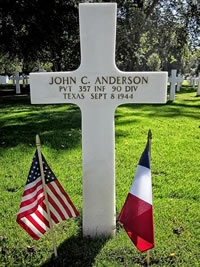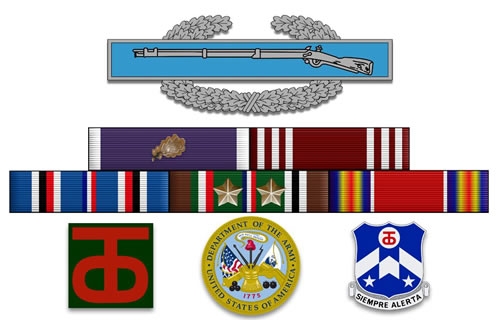 PRIVATE JOHN CLABOURNE ANDERSON
PRIVATE JOHN CLABOURNE ANDERSON
United States Army, World War II – Killed In Action
357th Infantry Regiment – 90th Infantry Division
 August 23, 2021 - John Clabourne was born in Nacogdoches County, Texas on August 30, 1908 to Annie Lawrence and William Marion Anderson. His parents were married there in 1900 and he had three brothers, Jewell Bernice (1903), George (1905) and James Willie (1907). John also had two half siblings from his father’s first marriage, Fannie Ophelia (1893) and Robert Lee (1896). The family lived on a rented farm in Shelby County as many did at that time and lived through the Great Depression in the early 1930’s. Father William died in 1938 at the age of 72 leaving John aged 31 to care for his 70 year old mother. By the 1940 Census they were living in Rusk County, Texas where John had employment as a laborer.(1)
August 23, 2021 - John Clabourne was born in Nacogdoches County, Texas on August 30, 1908 to Annie Lawrence and William Marion Anderson. His parents were married there in 1900 and he had three brothers, Jewell Bernice (1903), George (1905) and James Willie (1907). John also had two half siblings from his father’s first marriage, Fannie Ophelia (1893) and Robert Lee (1896). The family lived on a rented farm in Shelby County as many did at that time and lived through the Great Depression in the early 1930’s. Father William died in 1938 at the age of 72 leaving John aged 31 to care for his 70 year old mother. By the 1940 Census they were living in Rusk County, Texas where John had employment as a laborer.(1)
On October 16, 1940, John complied with the Selective Service Act of 1940 by registering for the military draft at Precinct 21, Rusk County, Texas. His Registration Card, D.S.S. Form 1 noted the following; Residence, RFD # 2, Garrison, Rusk County, Texas; Self-employed (unspecified); Description, Race white, five foot nine inches tall, 140 pounds with blue eyes, brown hair and a light complexion; Obvious physical characteristics, scar in left corner of left eye and tattoo on left and right arm.(2)
John and Miss Frankie Dee Woolley were married on Saturday, November 29, 1941 in Fort Bend County, Texas. Eight days later the Empire of Japan attacked the military bases at Pearl Harbor and Hickam Field, Hawaii. The United States was now involved in a second World War but this time on two fronts, Europe and the Pacific.
John received his draft notice and was inducted into the US Army, at the age of 33 on March 20, 1942 at Camp Wolters, Texas near Mineral Wells. Camp Wolters was one of the largest infantry replacement training centers in the US during WW II. He was then assigned to the 357th Infantry Regiment of the 90th Infantry Division (Tough ‘Ombres) that had been ordered into active service March 25, 1942 at Camp Barkeley, Texas near Abilene. Following basic training his regiment spent most of its time in the field with stress on physical conditioning and road marches up to 15 miles. In a five month span they took part in the Louisiana and California-Arizona maneuvers and by September 11, 1943 the Regiment was in place at its regular station, Camp Granite, California. Here more training and maneuvers to iron out final kinks for the task ahead in Europe. In December 1943 a four day train ride took John and his regiment across the country to Fort Dix, New Jersey where they had the luxury of living in regular barracks with steam heat and running water. Time was now devoted to weeding out the physically unfit men, securing serviceable equipment, range firing and most important, the granting of final furloughs. By March 15, 1944 the Regiment was up to battle strength and began moving by train to Camp Kilmer, New Jersey where final issues of clothing and equipment was made. On March 22 the Regiment moved to the New York port of embarkation and boarded the British ex-luxury liner, HMS Dominion Monarch that had been converted into a troop transport. At 0545 the next day the Regiment sailed docking at Liverpool, England on April 4 where they trained until June 4, 1944.(3)
The 90th Division entered combat on June 10 (D-Day+4) cutting across the Merderet River to take Pont I’Abbé in heavy fighting. The division then attacked to clear the Foret de Mont-Castre (Hill122), clearing it by July 11 in spite of fierce resistance. The Division suffered 5,000 killed, wounded, or captured, one of the highest casualty rates suffered in World War II. On July 27 they took Périers, a commune in the Manche department in Normandy in north-western France. On August 12, John and his Regiment as part of the 90th Division crossed the Sarthe River and helped close the Falaise Gap that was the decisive engagement of the Battle of Normandy. The Regiment then prepared to participate in the siege of Metz that began on September 14, 1944. Six days prior, September 8, Private John Clabourne Anderson, US Army Serial # 38125117 was killed in action. His comrades would fight on until Victory in Europe was declared, May 8, 1945. The Division suffered 19,200 total battle casualties that included 3,342 killed in action, 14,386 wounded in action, 287 missing in action and 1,185 taken as Prisoners of War.(4)
Following the Japanese unconditional surrender in the Pacific on September 2, 1945, World War II came to an end. More than 405,300 Americans died and families of those positively identified were offered burial options. They could choose burial in a new overseas military cemetery or bring the remains of their loved one home to the United States for burial in a cemetery of their choice. Frankie Dee chose to leave her husband buried with his comrades as did approximately 40% of other families facing the same decision.(5) From the temporary American Cemetery in Champigneulles, France John was reinterred at the new Epinal American Cemetery and Memorial, Epinal, Departement des Vosges, Lorraine, France. Day is done, God is nigh.
Epilogue: John was also wounded previously at an unknown date. His wife Frankie never remarried passing in 1967 at the age of 63. She is buried in the Center Hill Cemetery, Crockett, Houston County, Texas. Brother James Willie also served and survived World War II. Mother Annie lived to age 84 passing in 1954. She is buried with her husband William in the Walnut Grove Cemetery, Garrison, Texas.
“That these dead shall not have died in vain”…..Abraham Lincoln

Combat Infantryman Badge
Purple Heart (1 oak leaf cluster) – Army Good Conduct Medal - American Campaign Medal –
European African Middle Easter Campaign Medal (2 bronze service stars) - World War II Victory Medal
90 Infantry Division (Tough ‘Ombres) Insignia - 357 Infantry Regiment Insignia
References:
(1) Year: 1940; Census Place: Rusk, Texas; Roll: m-t0627-04131; Page: 2B; Enumeration District: 201-25
(2) The National Archives in St. Louis, Missouri; St. Louis, Missouri; WWII Draft Registration Cards for Texas, 10/16/1940-03/31/1947; Record Group: Records of the Selective Service System, 147; Box: 37
(3) Roeder, George. Regimental History of the 357th Infantry. First. Weiden, Oberfalz, Bavaria: Ferdinand Nicki Buchdruckerei, 1945.
(4) “90th Infantry Division (United States).” In Wikipedia, March 15, 2021. https://en.wikipedia.org/w/index.php?title=90th_Infantry_Division_(United_States)&oldid=1012197790.
(5) General Information. Accessed February 6, 2021. https://www.cem.va.gov/CEM/publications/NCA_America_WWII_Burial_Program









